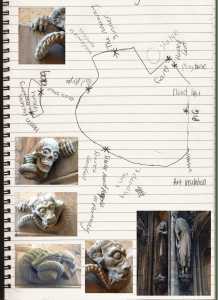Today’s demonstration was to present the range of ideas we have discussed and wish to include in our final piece so we worked on what we thought we wanted and what our work should be based on.
We worked on the writing with chalk task in Pottersgate (https://flic.kr/p/rxyLQB ) and the ritual with St Anne’s well (https://flic.kr/p/qAzbDY ).
The chalk task consists of the participants thinking of a wish or a good memory that they would like to reflect on and then them actually transferring that into a physical mark on Pottersgate. By making this physical mark, they have, in effect, ‘set it in stone’ on stone as that is what the pavement is made of. The participants will have already been made aware that this will not be a permanent mark and that they will be washing it away however, before they do that, the very act of making the mark is a tangible confirmation of their wish or memory being made permanent albeit fleetingly.
At St Anne’s Well, we wanted to make our own version of the folklore ritual which involves walking round the well 7 times and then placing a finger in one of the holes in the door to find out if that person is going to heaven or hell. We wanted to add some new rules to the ceremony so, as the participants went round the well, they might be asked to ‘place your hands on the roof’, ‘turn around and shout the first thing you see in your surroundings,’ or ‘make a wish on one of the bricks’ for example; this would add our own little twist to the whole procedure.
As these were the only things we could come up with, we were aware that we were not fully connecting and linking together so eventually, as a group, we decided on the idea of giving a misguided tour from Pottersgate to the Cathedral garden whereby we tell real stories of the places as well as sham stories that we have created.
Since I did not properly understand the meaning of a ‘misguided tour’, I searched for it on Google and found some very interesting websites one of which included: http://www.foolsfestival.com/2013/misguided-tours/ .
These ‘misguided tours’ are very popular with the public and obviously great fun as they involve the participants listening to ‘hidden stories’. These can only be described as real stories with a mysterious or magical twist that have been recounted by local people or are similarly made up tales. The idea of doing some ‘hidden stories’ really appealed to me especially if we could find some by asking those people who are longstanding natives of Lincoln.
I still wanted a clear description of a misguided tour however so I found a good explanation:
“We like to blur the distinctions and play across the boundaries of the real and the fake…They will amuse you with their irrelevant insights and entertain you with their opinions on everything but the hard facts.”
This great quote is from Fuse Performance who base their work on the events or the place they go to such as Belfast, Glastonbury festival etc. http://www.fuseperformance.co.uk/fuse_Performance/Gallery/Pages/Misguided_Tours.html
I continued with my research and came across a fascinating YouTube video of an interesting artist called Willard Morgan https://www.youtube.com/watch?v=6CMUT53tjNY. He created a character called ‘Gino Gelati’ who, from the YouTube description, is “possibly the world’s worst travel guide.” His special ability is that he can make the truth merge with obviously fake ideas that just pop into his head and while it is not believable, it is very funny and quite amusing to watch. I researched him further and found his website http://willardmorgan.com/ only to discover that he is a filmmaker, artist, photographer, actor and comedian and is involved in many different materials of the arts such as music and film.
So, the next step is for my group and I to reflect on what I have researched and then consider the idea of searching out some hidden stories told by the public and/or making up our own interesting stories associated with our chosen areas.
My next job is to look at psycho-geography and myth-geography in urban areas.





